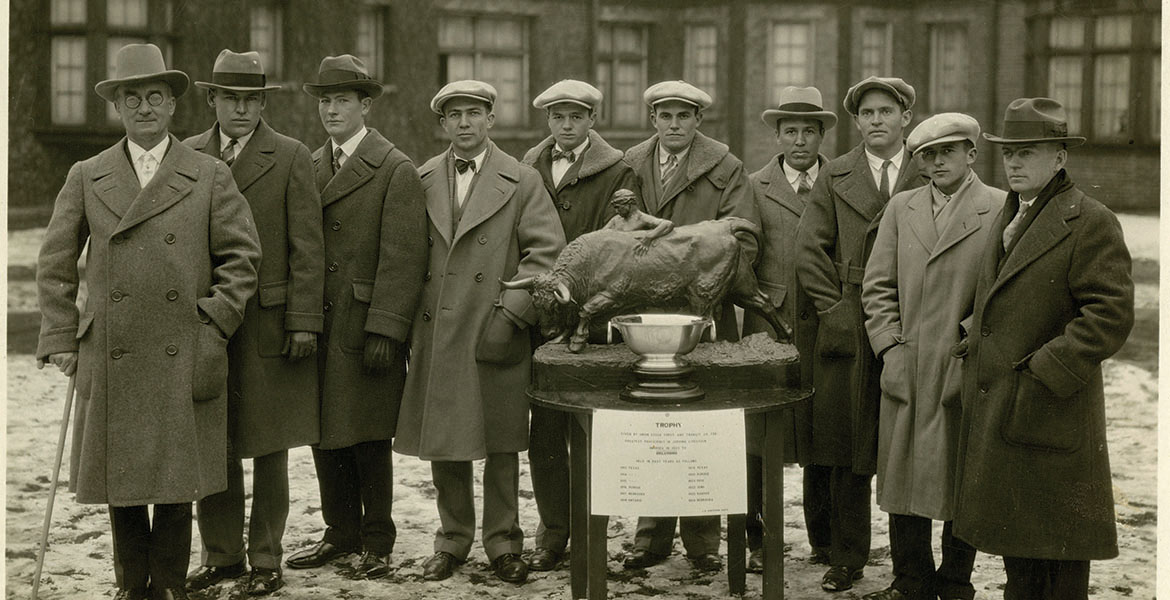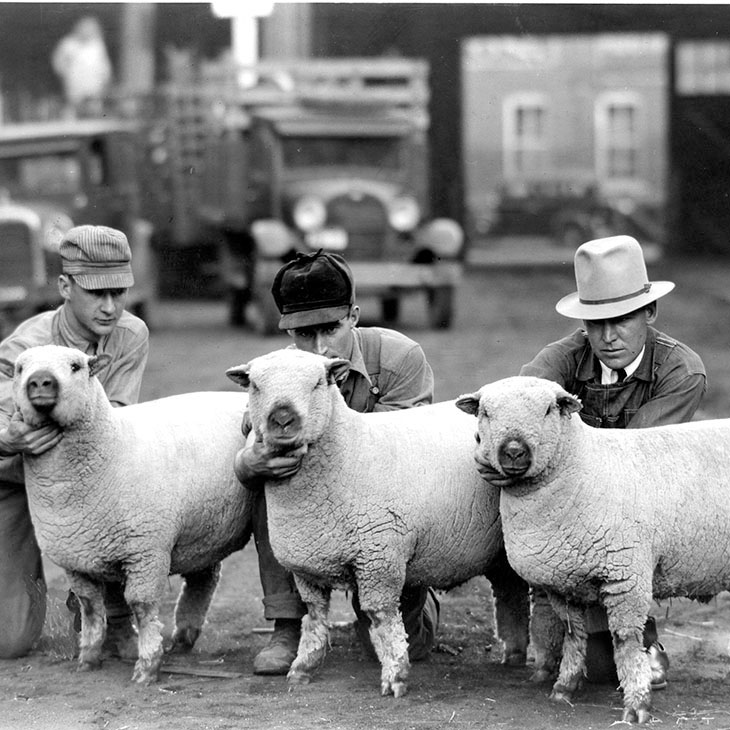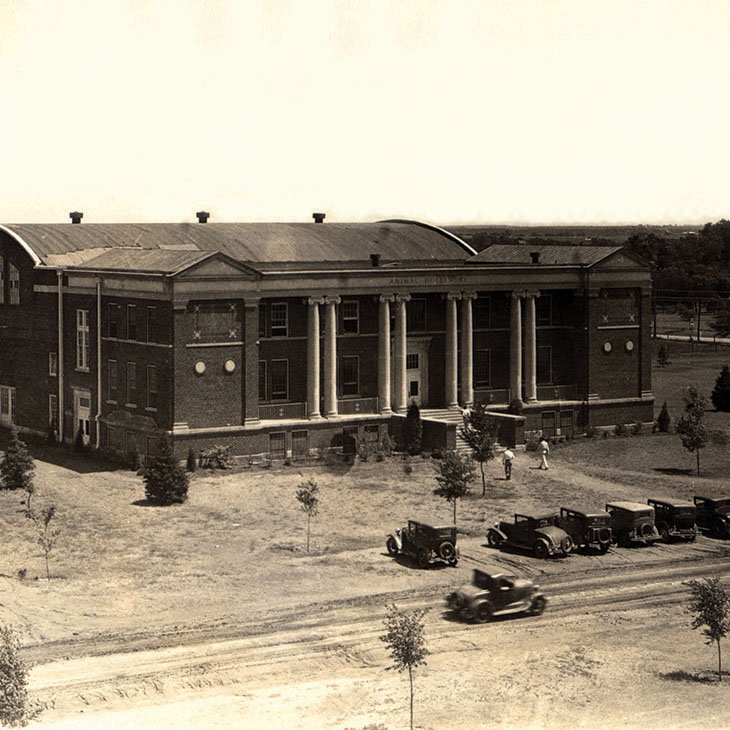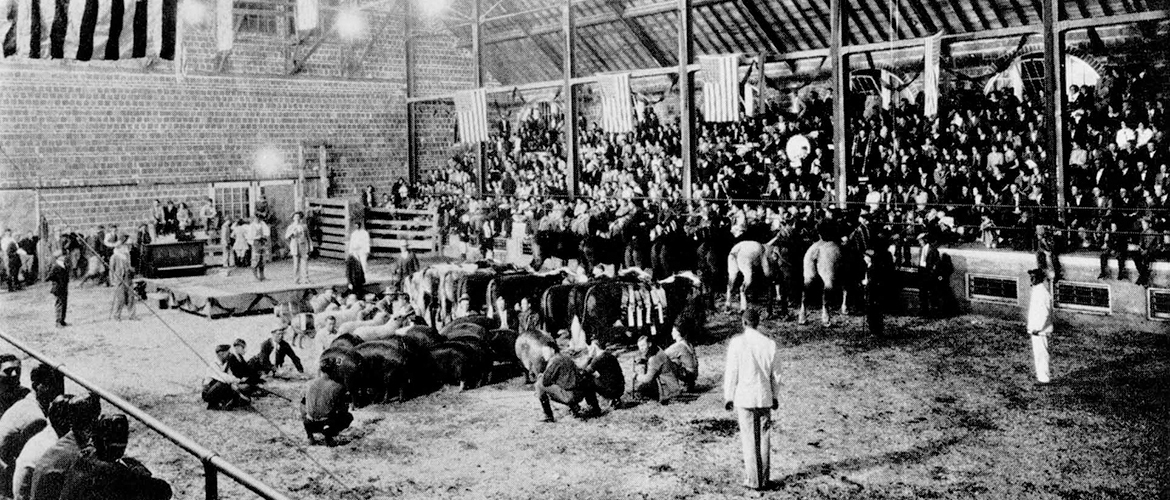
Cowboy Chronicles: OSU's first national team championship came in livestock judging
Thursday, May 14, 2020
The animal husbandry program at Oklahoma A&M College began as the first livestock judging contests in Chicago — the hub for much of the U.S. meat industry — were taking place.
Frank Burtis introduced the course in Stillwater in 1899. He requested literature from registered livestock associations because despite the variety of livestock breeds at the experiment farm, most were of poor quality and far from breed standards.
In 1902, Burtis took his students to the American Royal Livestock Exposition at Kansas City for their first competition out of Oklahoma.
In 1913, coach Charles I. Bray took the team to the International in Chicago, where they came in last. Team members had rarely worked with prize animals, and their scores reflected their inexperience.
The loss prompted the college to take steps to improve future stock judging outcomes. The Oklahoma Agricultural Experiment Station initiated efforts to enhance the livestock breeding programs and expanded acquisitions of registered stock from other states and countries, qualified faculty were hired, and new facilities were eventually built.
“(Livestock) judging instills confidence in those people who may be timid and humbles those who tend to be conceited.”
John A. Craig, director of the station beginning in 1908 and a leading international authority on livestock, purchased Percheron draft horses from France and acquired the first purebred Dorset and Shropshire sheep imported from England. Craig developed the first criteria for livestock judging used at the turn of the century, was instrumental in establishing the International in Chicago, and led the first efforts to improve the breeding stock at OAMC.
Warren L. Blizzard joined the OAMC faculty on Feb. 18, 1915, only to discover there were no herd bulls for the beef cattle breeds. He quickly bought 28 head of breeding stock for the experiment station. Blizzard provided a stable academic environment and attracted experienced faculty who established careers with expertise in poultry, beef, dairy, swine, sheep and horses.
Student training and educational experiences improved dramatically. College faculty members served as livestock judges at competitions in the state, region and nation and mentored students. Quality stock judging coaches such as Blizzard and William Fowler challenged their college teams and raised expectations. The breeding program enhanced the quality of the livestock students were exposed to, college livestock won ribbons at state and regional competitions, and the results for the livestock judging team improved as well.
But the school still lacked good facilities. The first building planned and completed under the administration of OAMC President Bradford Knapp was a new Animal Husbandry Building and Livestock Pavilion, located at the east end of Farm Road. It was part of the college’s efforts to develop an agricultural center. In the 1920s, 70 percent of Oklahoma’s population lived in rural areas. The college hoped to attract statewide gatherings of farmers, provide an arena for livestock competitions and exhibitions, and support the Animal Husbandry Department with office, laboratory and classroom space. Construction started in January 1924 and by September, the facility was completed except for utilities connections.
Albert Darlow graduated from OAMC in 1919. He immediately joined the staff of the Animal Husbandry Department and began working on his master’s degree, which he completed in 1922. During graduate school, Darlow served as the assistant coach with the livestock judging teams.

OAMC student judging teams were soon competing at national events in dairy, poultry, meat and grains, but in the early years, the collegiate livestock judging teams had the greatest success at competitions in Oklahoma, Texas, Kansas and ultimately at the International in Chicago.
The OAMC chapter of the Block and Bridle Club sponsored the Little International event in the new Animal Husbandry Livestock Pavilion on Oct. 22, 1925, with 1,600 people attending. The program featured an exhibition of the college’s prize livestock, demonstrated livestock judging skills and included a rodeo, society horse show, rope tricks, dance act and style show, lasting for more than three hours.
In November 1925, the college sent its team north for the competitions that would culminate in Chicago. Darlow, now the team’s head coach, remained at OAMC to teach. The team first traveled to Wichita, Kansas, then finished sixth at the American Royal in Kansas City.
They visited livestock farms in Kansas and Missouri before heading to Ames, Iowa, where they practiced judging the herds at Iowa State College. They stayed briefly at the University of Minnesota and the University of Wisconsin before heading to Chicago. Blizzard accompanied the men, but he focused his attention on the livestock, while the team examined horses, beef cattle, sheep, hogs and varying classes of animals within each group.
The team reached Chicago on Thanksgiving morning. That afternoon they watched future legendary NFL player Red Grange appear in his first professional football game. They relaxed on Friday and went to the stockyards early Saturday morning. The judging lasted until 9 p.m., and the men returned to their hotel thinking they had finished in second place. At 2 a.m. Sunday, they were notified they had won.
The OAMC team scored 4,459 points out of a possible 5,000. The team was first in judging horses, third in cattle, fourth in sheep and seventh in hogs. Seniors Louis E. Hawkins and Charles W. Weathers tied for seventh place overall with individual scores of 902. Junior William D. Gray and seniors Harland R. Hamm and Raphael E. Herndon completed the scoring with an 885 average. Blizzard’s livestock placed first in eight categories.

Once he was notified early Sunday morning of the team’s victory, OAMC President Knapp joined Coach Darlow in traveling to Chicago to celebrate with the team.
The International hosted a luncheon for them Sunday that included exposition officials, team coaches and Chicago stockmen. Sunday evening, they were the guests of honor at the American Society of Animal Production Association banquet in the Saddle and Sirloin Club at the stockyards, with over 500 attending. The team provided short presentations at both events.
The Society Horse Show honored them on Monday with a silver loving cup for being the top team judging Percheron horses, which had also placed them in first place overall. And Tuesday, an Oklahoma A&M banquet at the Morrison Hotel drew OAMC alumni, Knapp, Blizzard, Darlow and the team.
“It seemed like we shook hands with everyone in Chicago when we won first place in the judging contest at the International Livestock Exposition. It all seemed like a dream,” Weathers said.
With the win, the team received the grand prize: the traveling Union Stock Yard and Transit Co. Trophy of a bronze bull and man, which weighed about 300 pounds. OAMC displayed the trophy on campus until the next International, and the national Block and Bridle Club presented them with a silver loving cup as a permanent trophy.
A Stillwater celebration was delayed a bit, as it took a while for the team members and livestock to return home. President Knapp held a special assembly on Dec. 9, 1925, honoring the OAMC team as well as the Garber (Oklahoma) High School team and its coaches, Rufus Cox and Paul Adams, both OAMC graduates in animal husbandry. The Garber team took first in high school judging at the International, and three of its members said they would enroll at OAMC.
The college would achieve permanent ownership of the Union Stock Yard and Transit Co. Trophy after winning its third championship under Coach Darlow in 1928. The team won in 1926 and had the top individuals in 1926 and 1928, James Culbertson and Carl Williams, respectively.
OAMC animal husbandry students excelled on a national stage with the superior teaching, quality resources and outstanding facilities in Stillwater, providing a wonderful model for all university programs, and establishing a tradition of excellence that lives on today.

